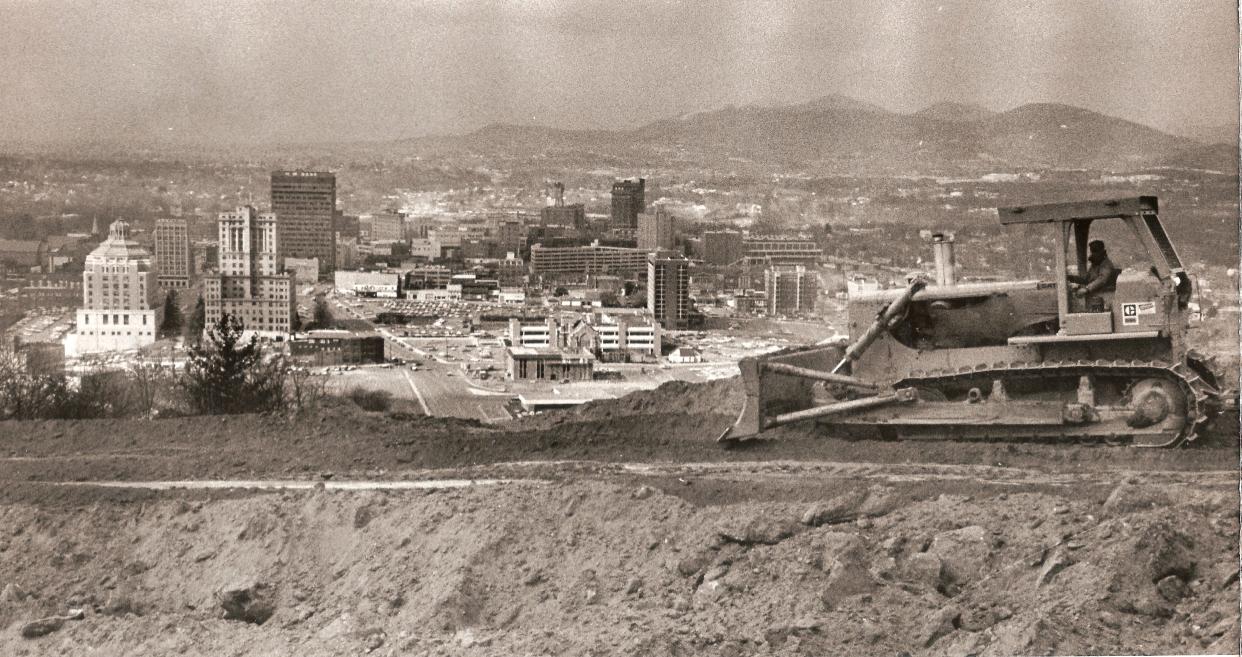Visiting Our Past: Mountain's majesty yielded to transportation necessity

In 1989, Buncombe County commissioners changed the county motto from "Men to Match Our Mountains" to "People to Match Our Mountains." The gender issue was resolved, but the meaning of "match" remains in doubt.
Does "match" mean that Buncombe people have characters as great as the mountains and revere them? Or does it mean that they are as mighty as mountains and can clear them for population growth?
The issue came to a head from 1964-77 when the need for an interstate highway through downtown resulted in an 800-foot wide cut in Beaucatcher Mountain.
This is Part 2 of a two-part feature.
The dispute has life in contemporary affairs and has roots in Asheville history. Hills in Montford had been leveled in the 1890s to produce fill for Pack Square and Patton Avenue. E.W. Grove tore down Battery Park Hill in 1923 to make way for a business district. The state Department of Transportation has been a force in mountain blasting throughout the region. When, in 1976, the movement went forward to create the open cut rather than build tunnels through the mountain, City Council member Gene Rainey stated, "We are witnessing an unprecedented attempt at bureaucratic bullying."
Visiting Our Past: I-240 passage reminds us how great things were done
You may also like: Visiting Our Past: History, geography may define WNC regions better than new boundaries
Rainey's cry of "dictatorship by bureaucracy" and "denial of our constitutional rights" echoes a regional theme that has played from settlement times through the Civil War to contemporary politics: a fighting for self-rule and distrust of big government. The isolation that mountains create is good in the local world view.
In Buncombe's formative years, the mountains attracted Scots-Irish highlanders with a matching ethos. The geography also bestowed a sense of nobility that transcended money, though moneyed people also drew inspiration from the landscape.
One of those moneyed people was Philip Henry, who bought John Evan Brown's Beaucatcher estate, Zealandia, soon after arriving in Asheville in 1904. He built a Tudor mansion (still standing), and opened Asheville's first art museum (razed by the DOT in 1976). Henry designed a frieze in the dining room of the main house, modeled after 15th-century painter Benozzo Gozoli's fresco "The Arrival of Three Kings."
When efforts by the Beaucatcher Mountain Defense Association failed to stop the cut on the basis of mountain preservation, it focused on Zealandia, protected by the 1966 National Historic Preservation Act. Zealandia sat 400 feet from the cut.
Whereas debates about cost, traffic, safety and timeliness had dominated politics previously, terms like "res judicata" and "laches" became part of the local vocabulary. The first term refers to whether the issues of a suit have already been resolved in court, the second to whether litigants have delayed their suit to the detriment of the community.
The laches argument was particularly significant. Plaintiffs demonstrated that there had been no delay and that the historic preservation issue could not have been pursued until the site had been threatened.

According to regulations, a survey of historical significance was a federal responsibility.
Preservation had become a national concern. States were considered unreliable advocates because of local ties with commercial operations. When Zealandia was placed on the National Register of Historic Places on March 14, 1977, blasting had already begun.
Rob Neufeld wrote the local history feature "Visiting Our Past" for the Citizen Times until his death in 2019. This column originally was published April 8, 2009.
This article originally appeared on Asheville Citizen Times: Visiting Our Past: Mountain's majesty yielded to needed transportation

